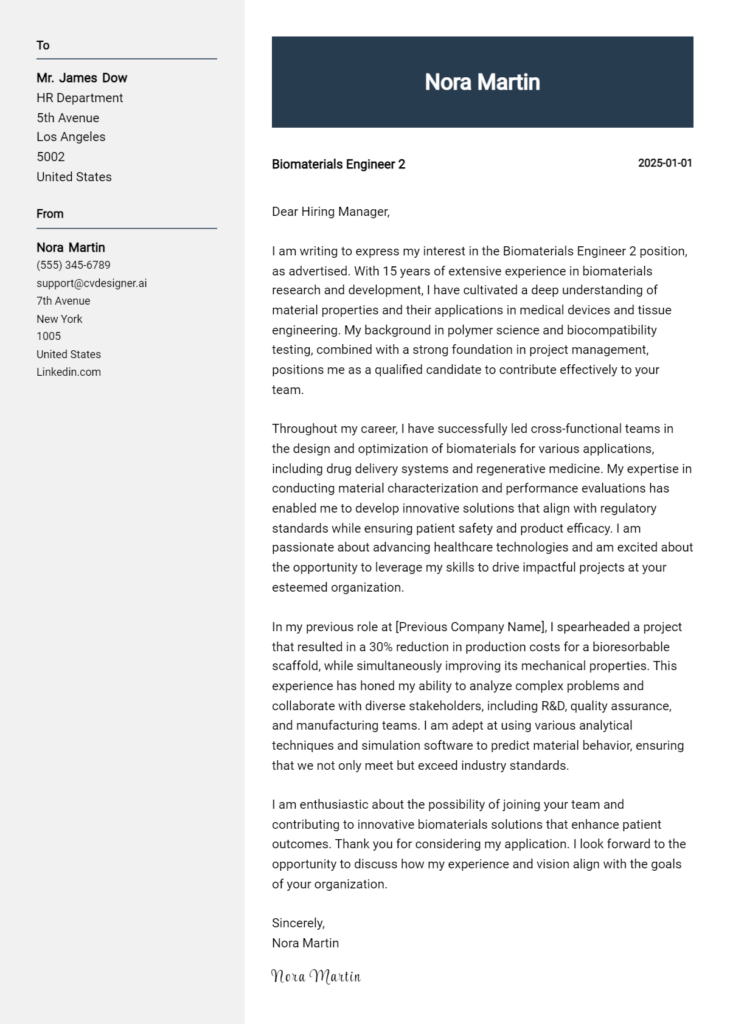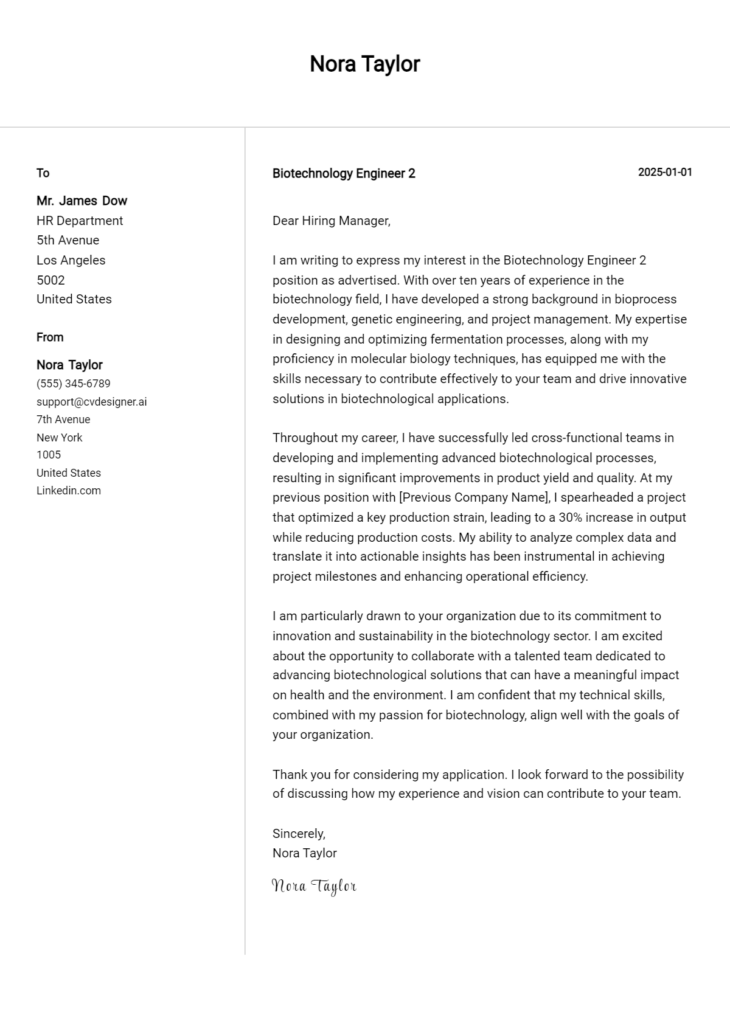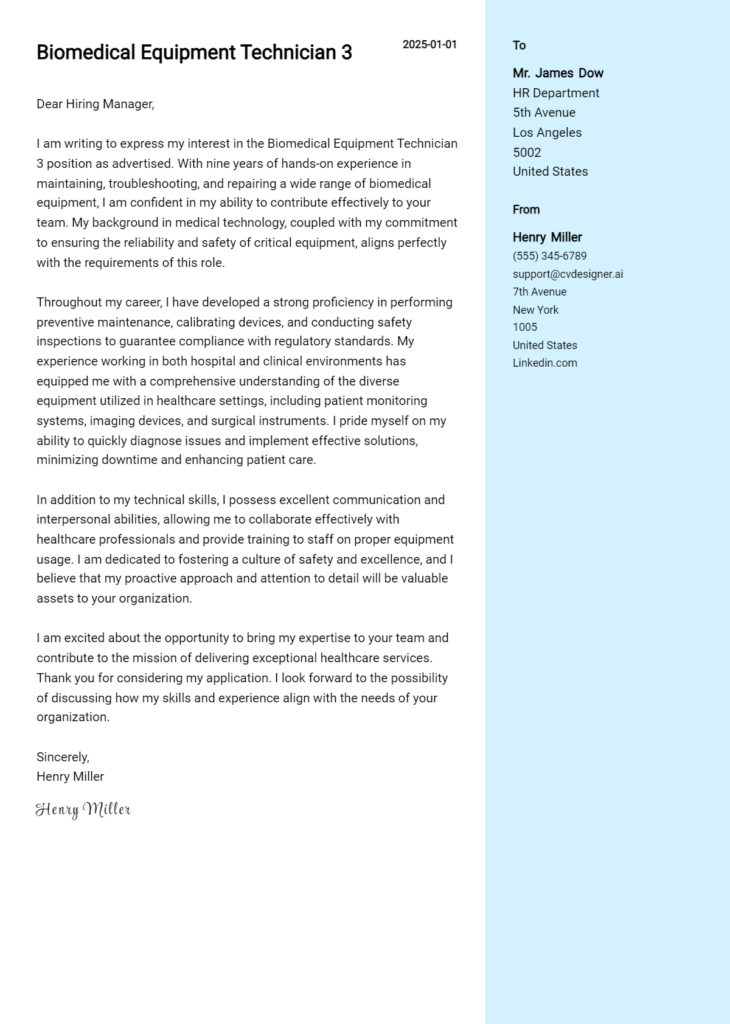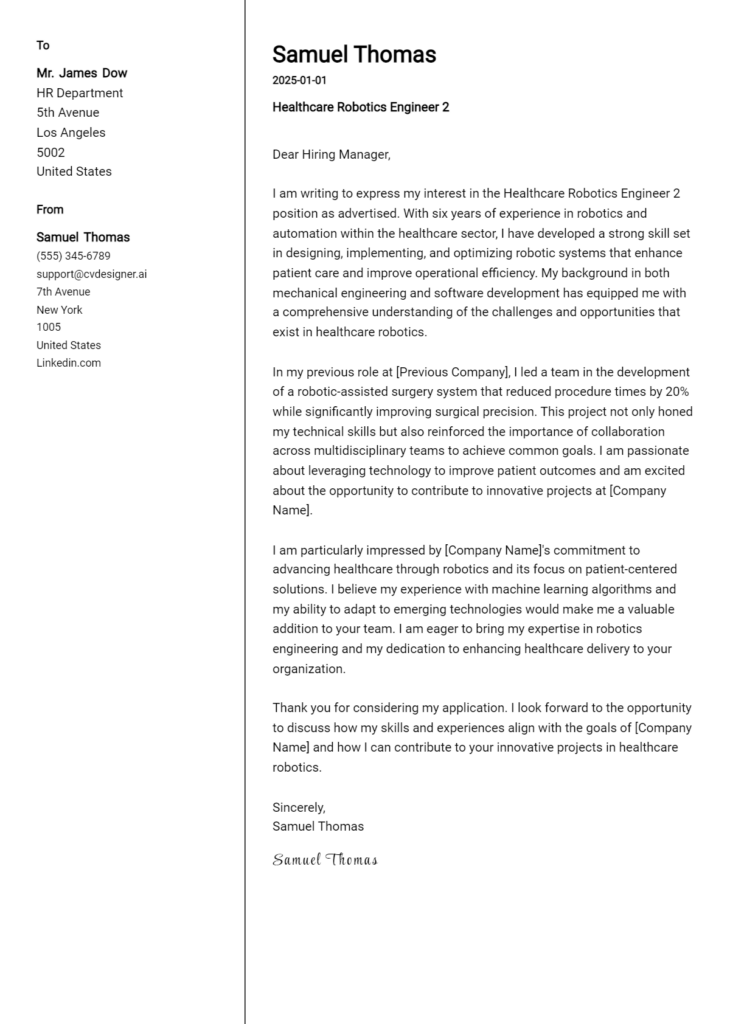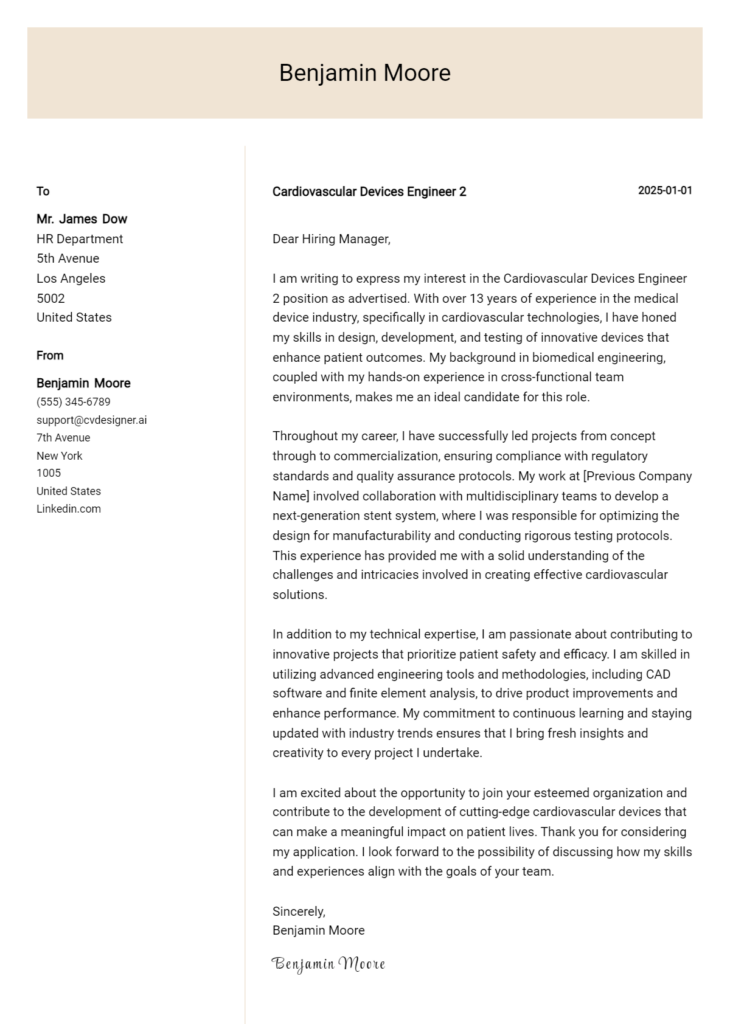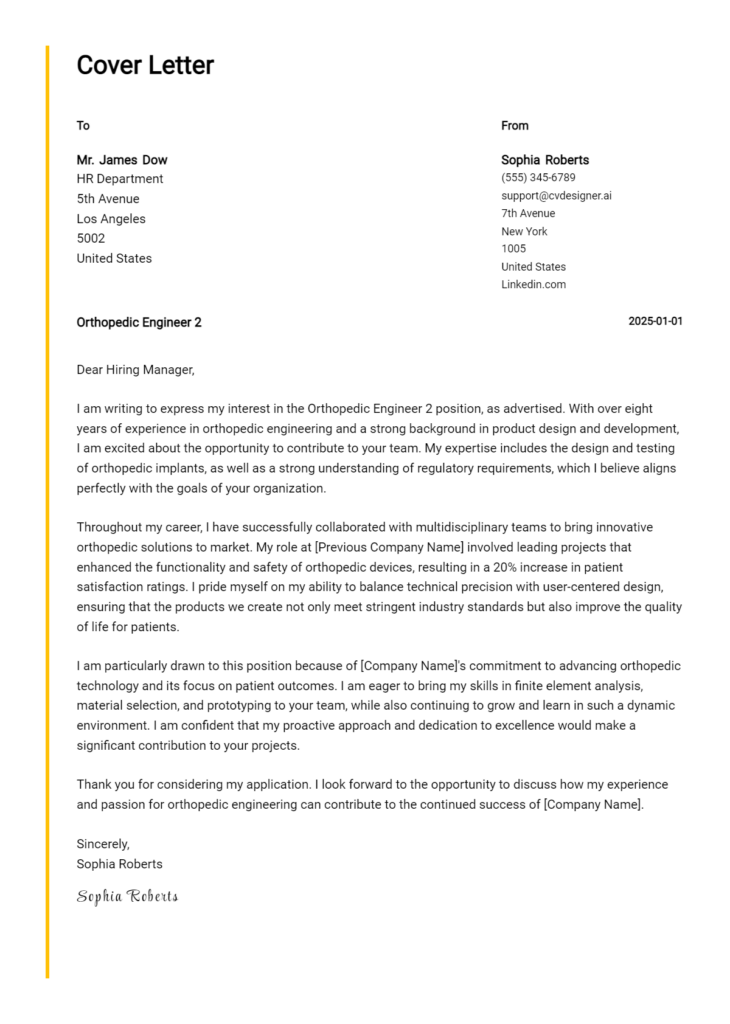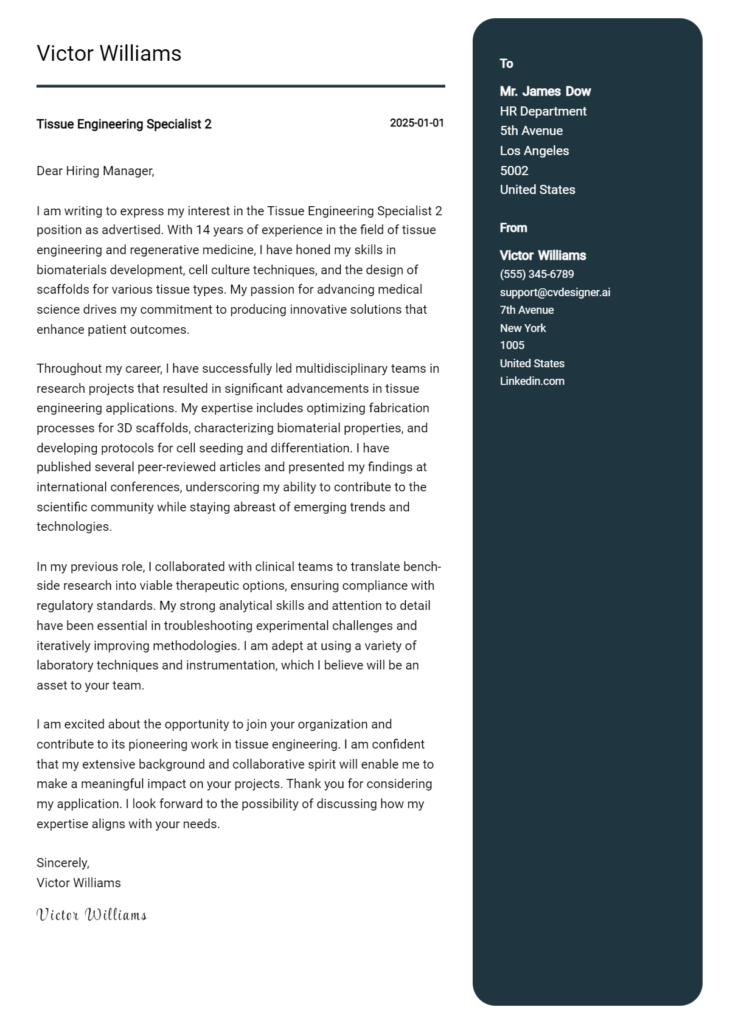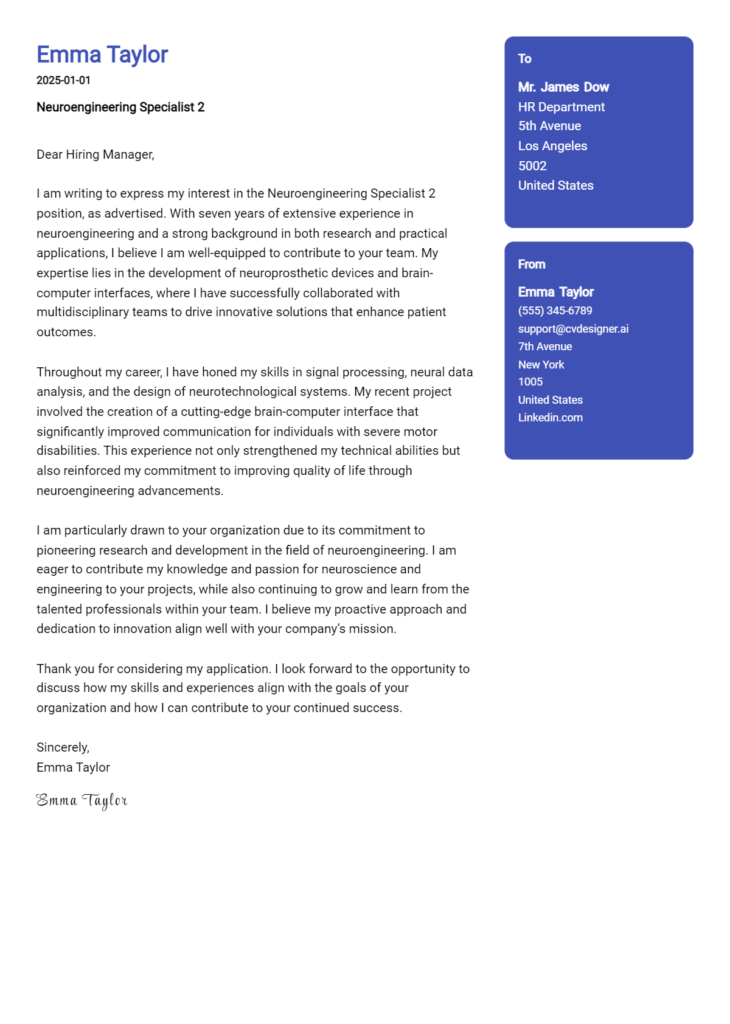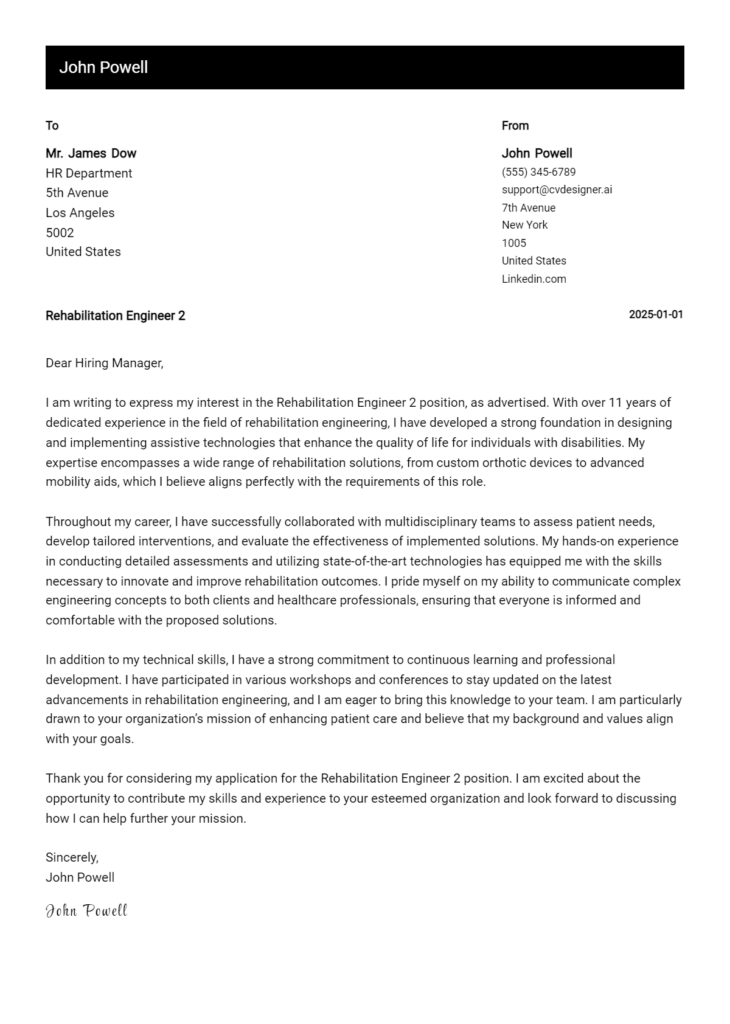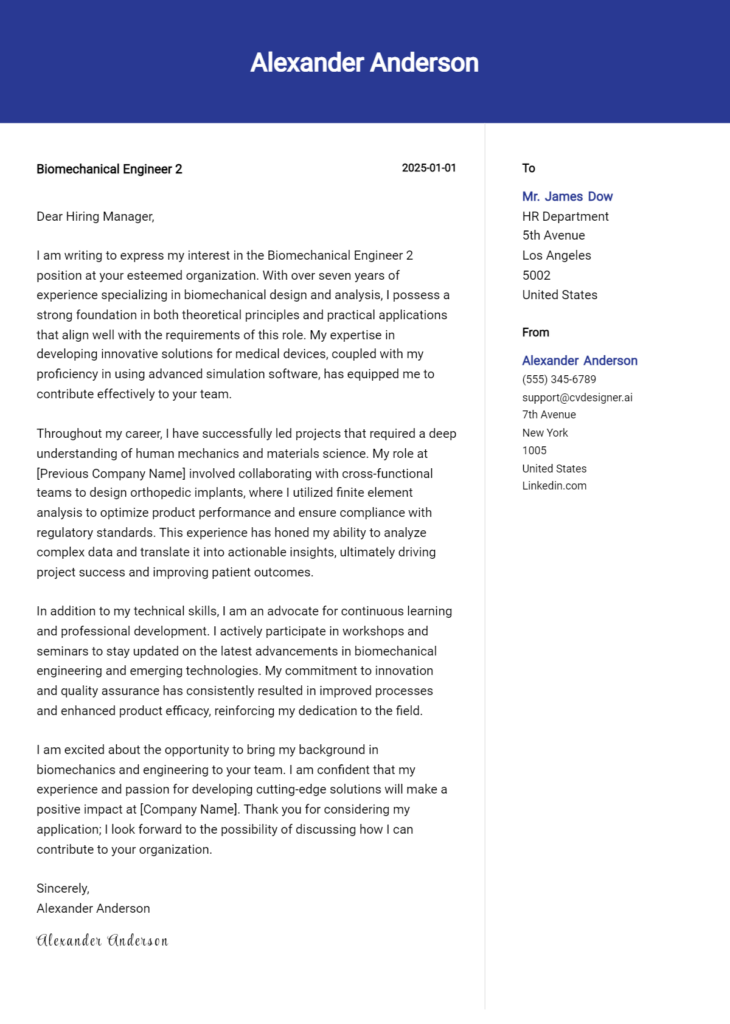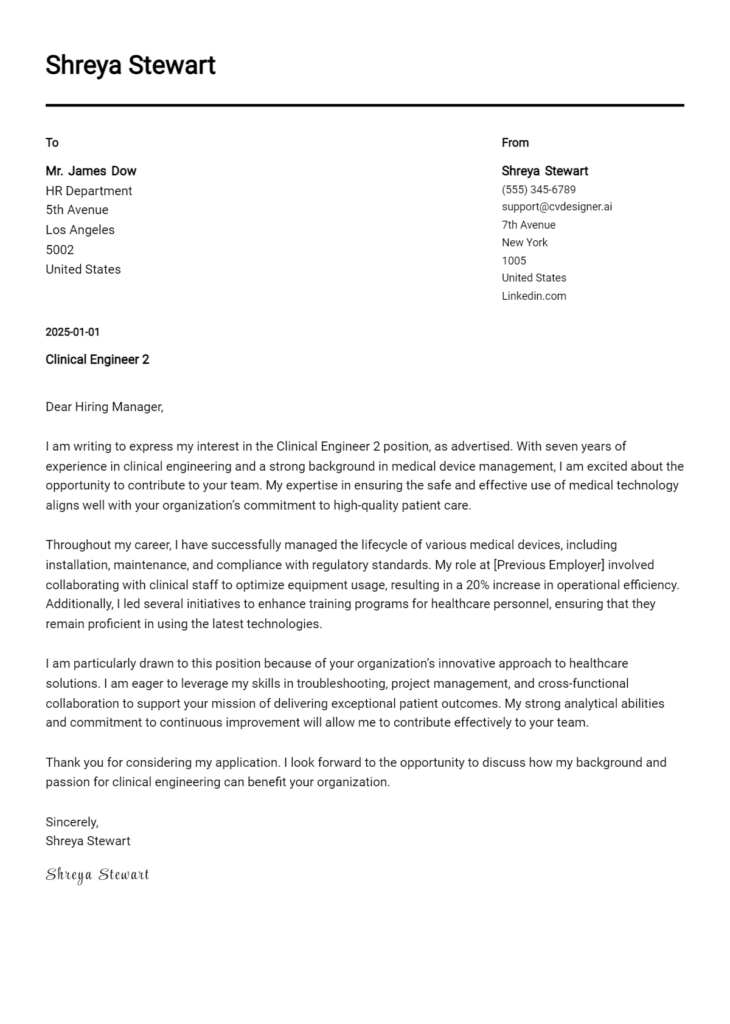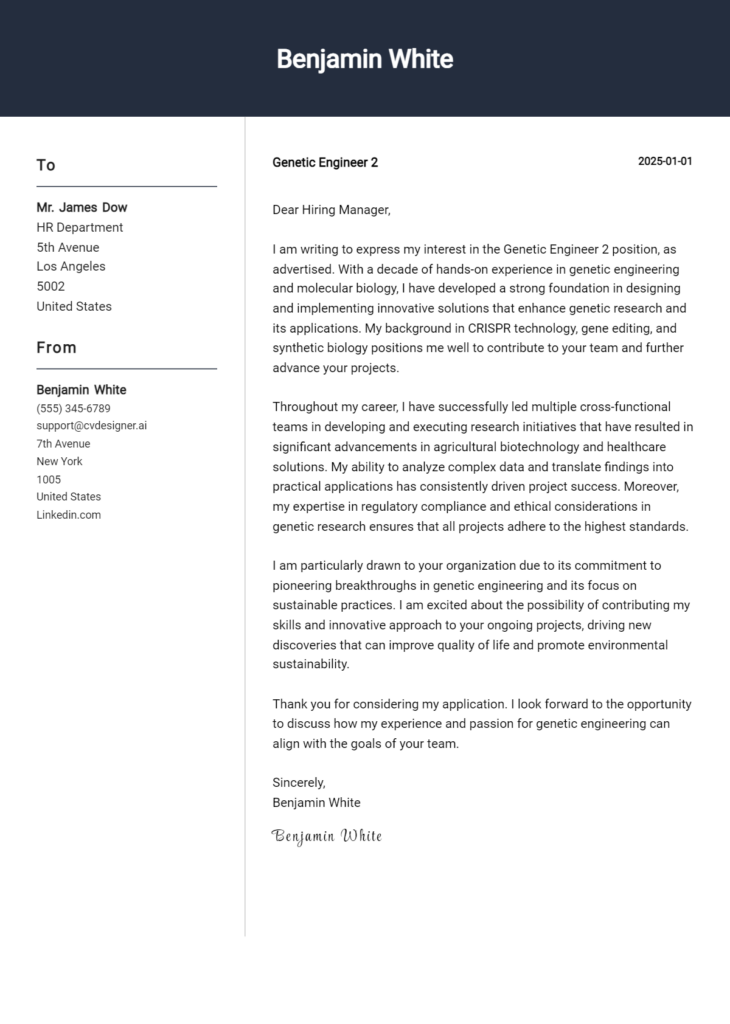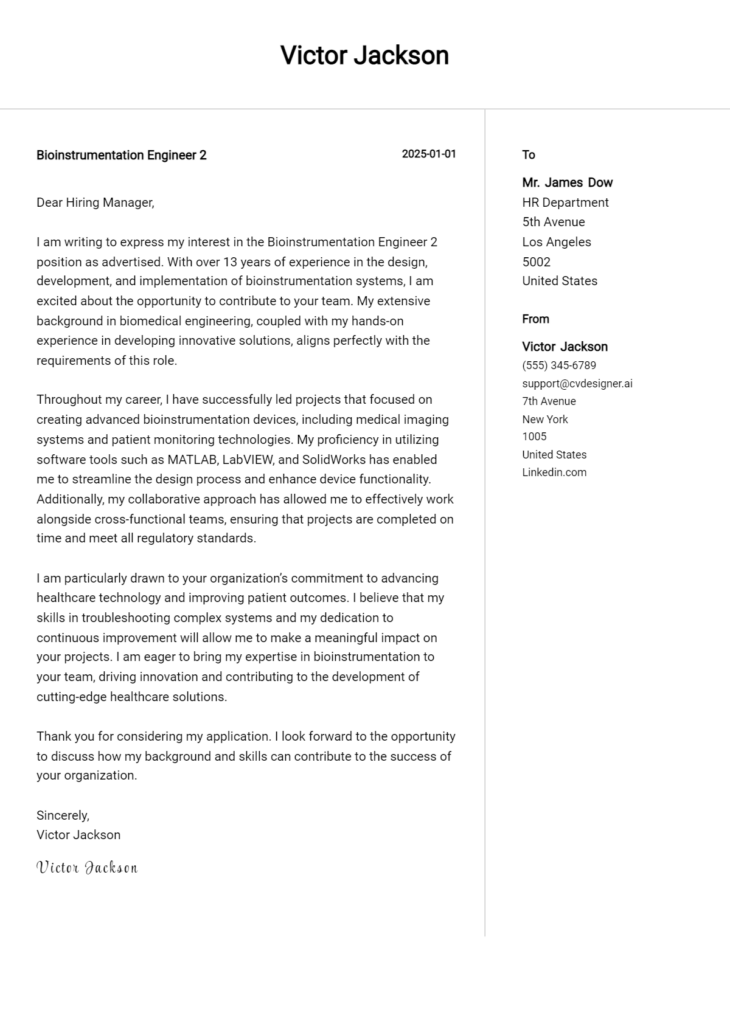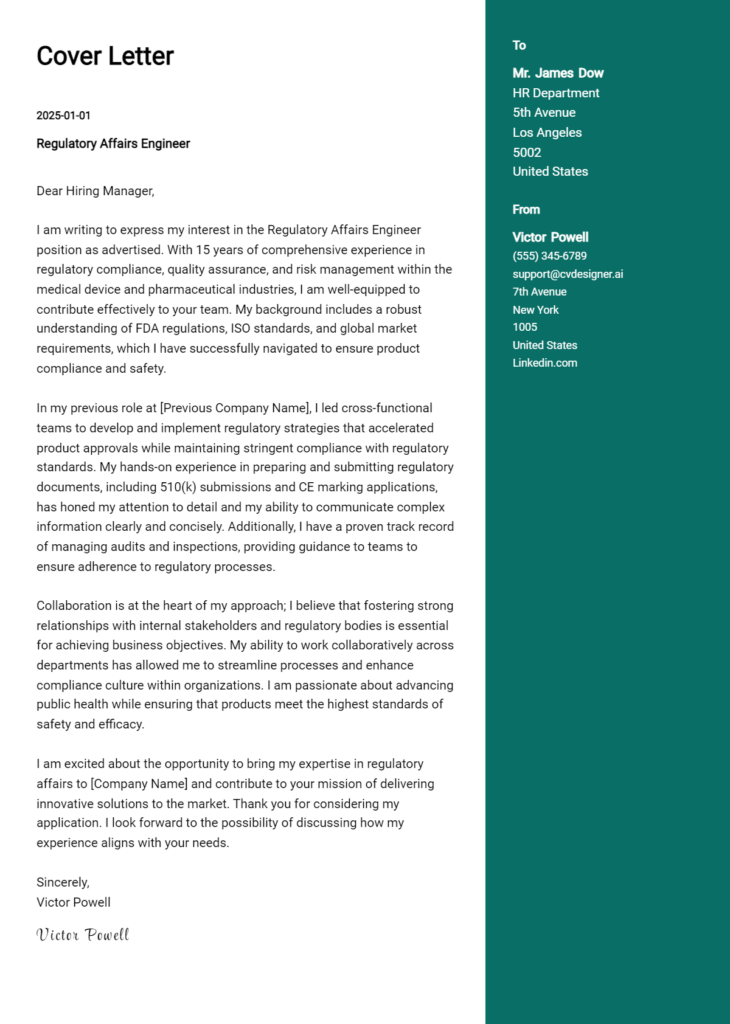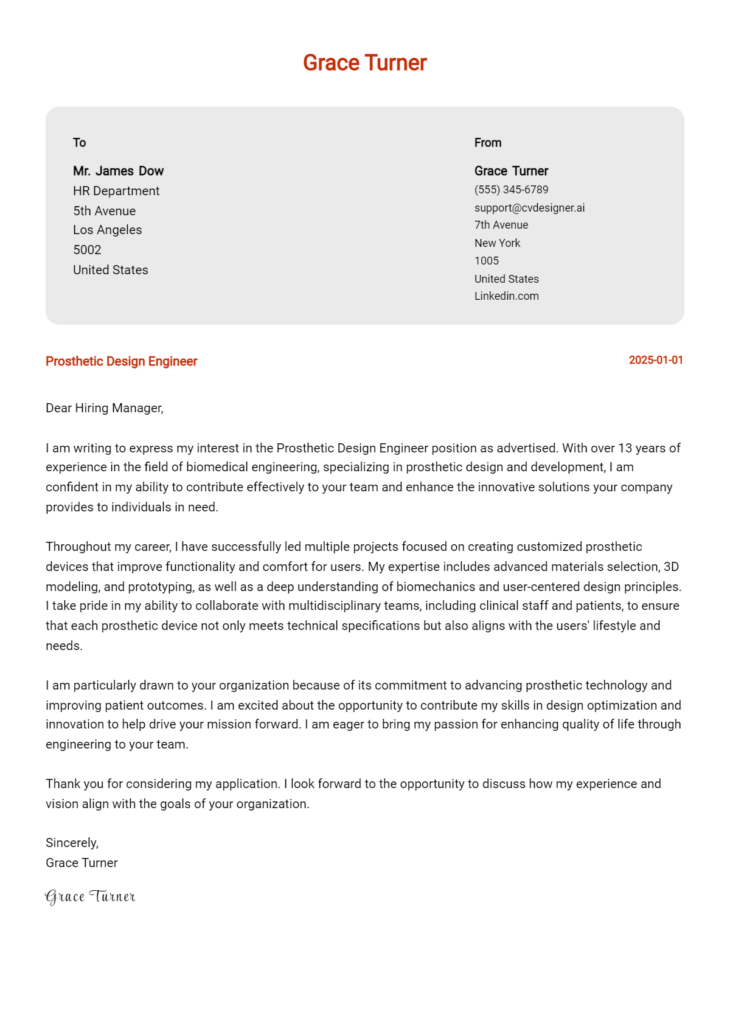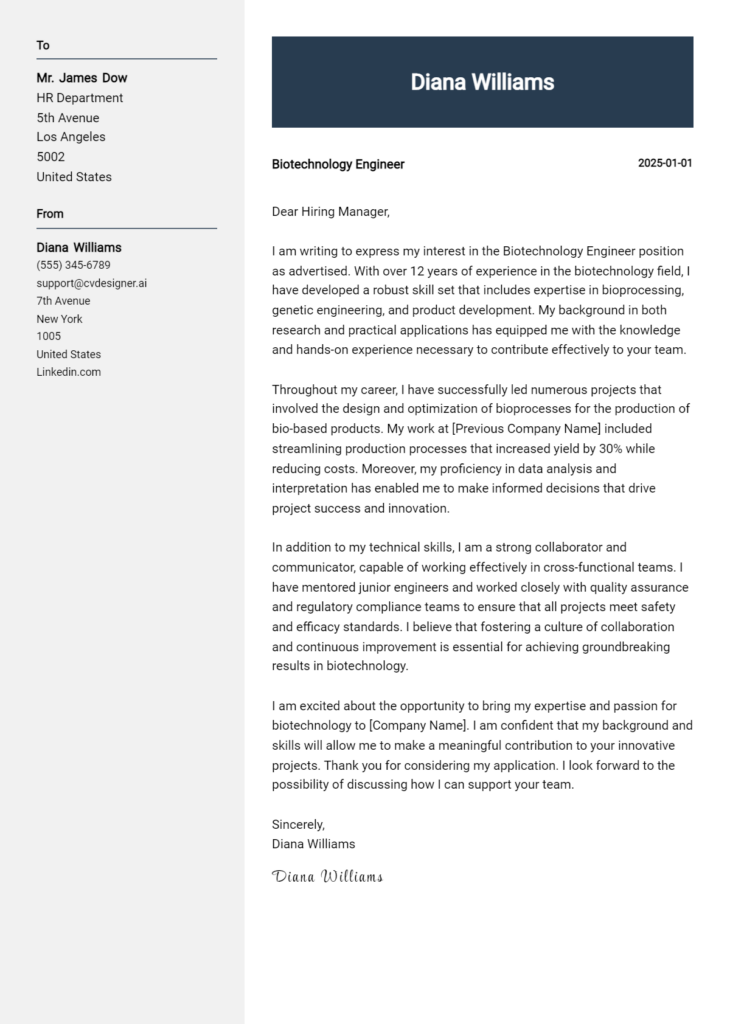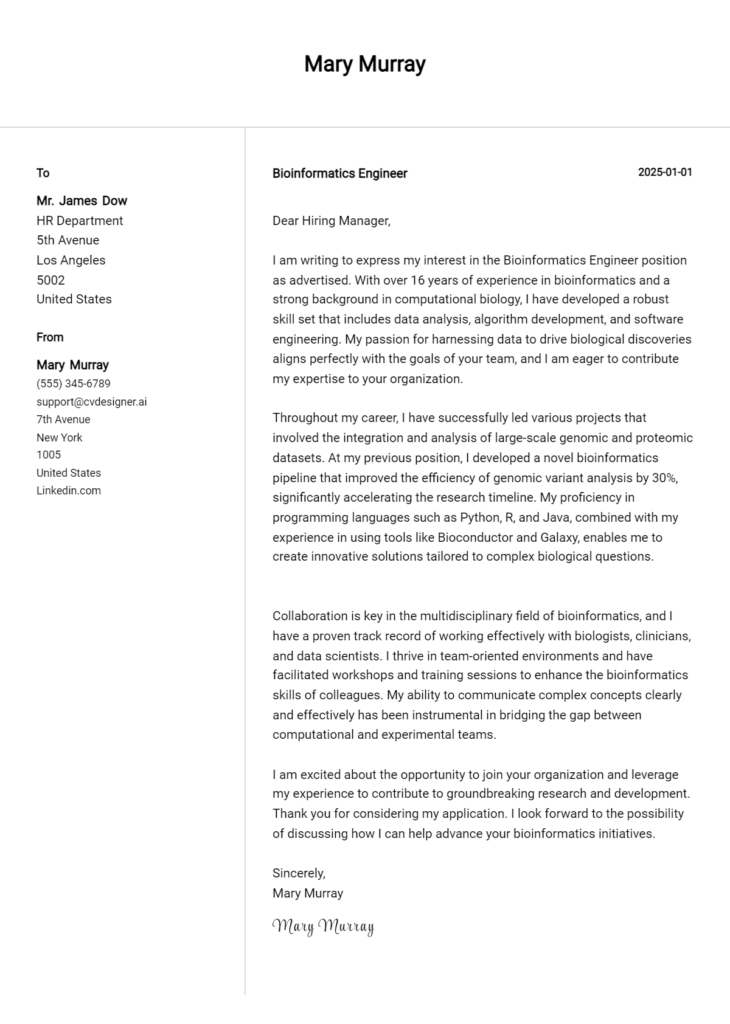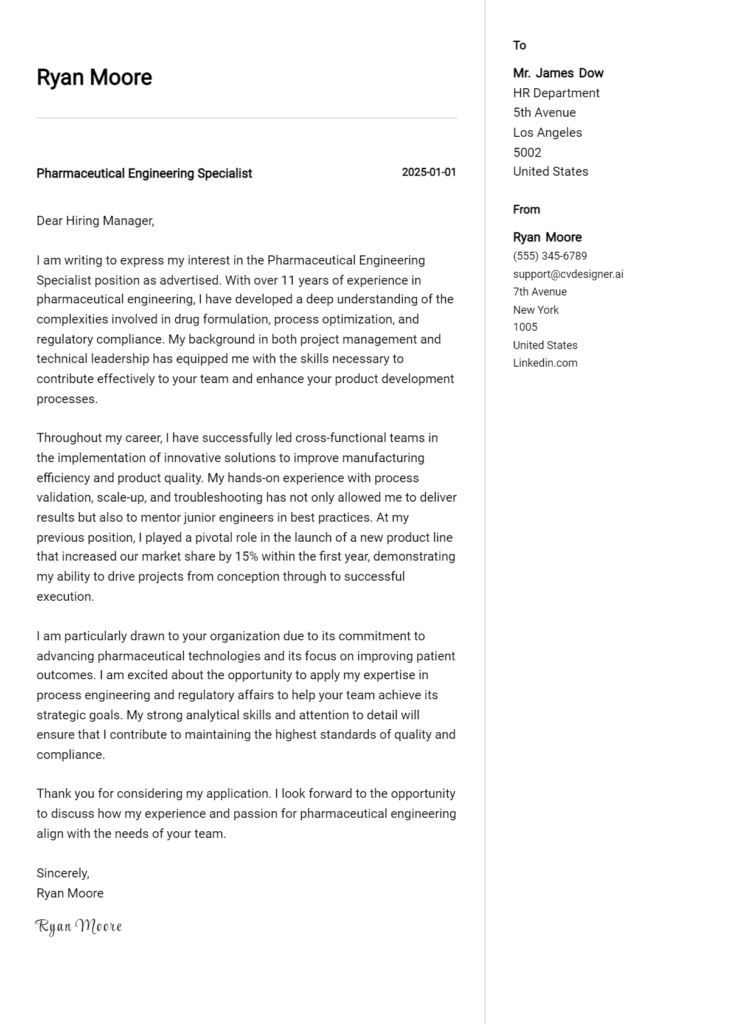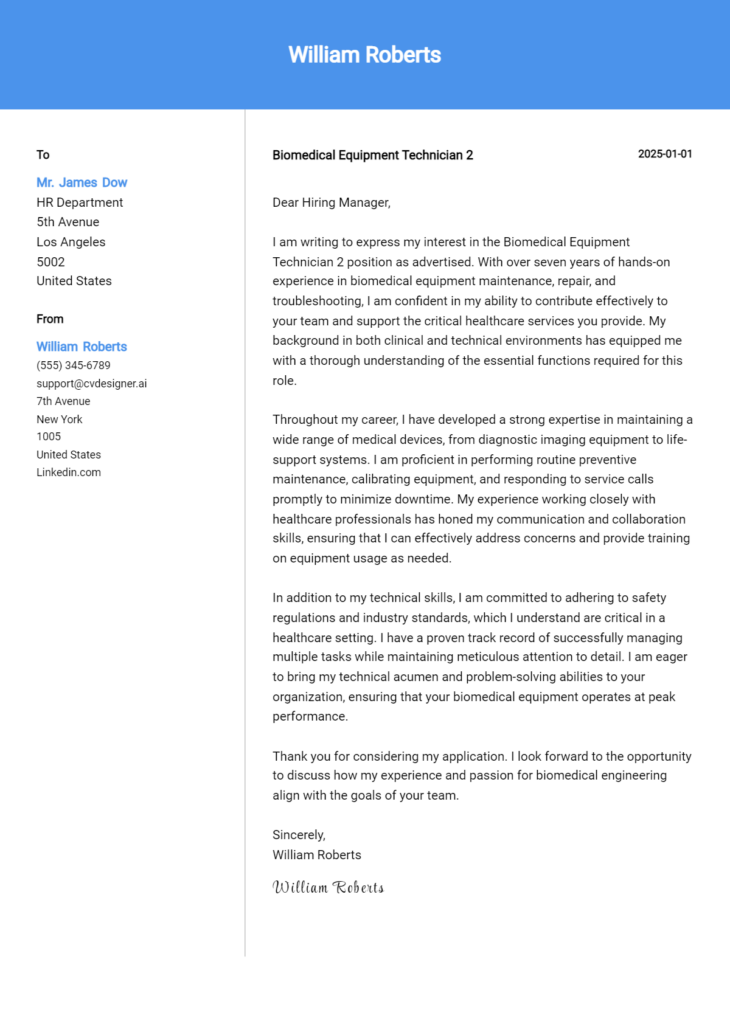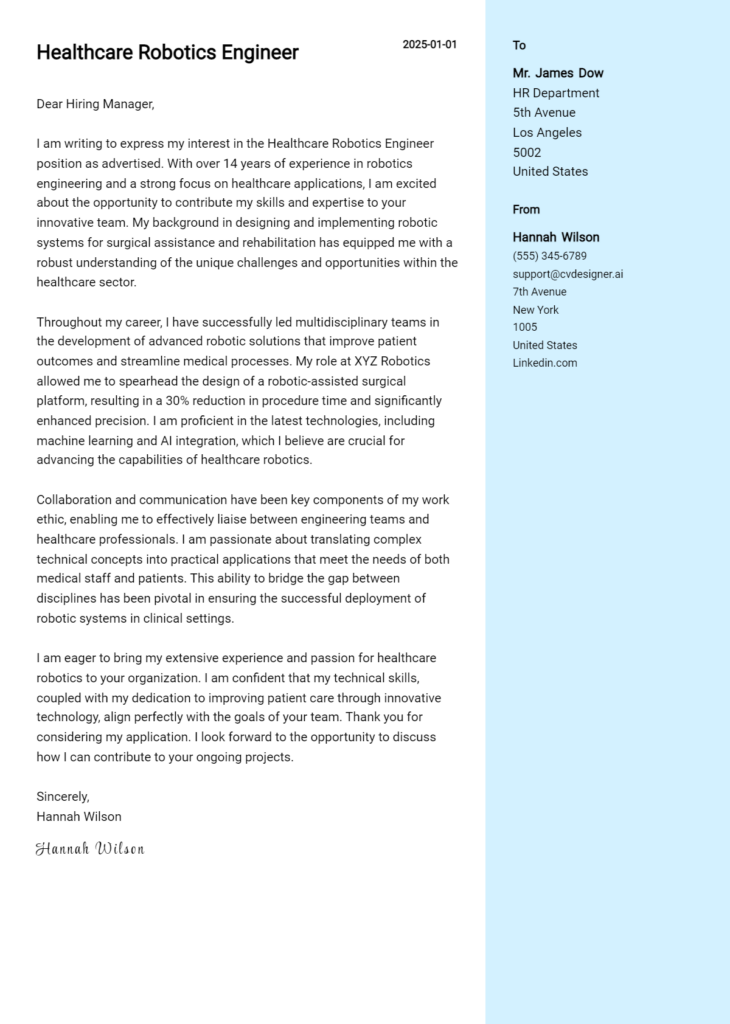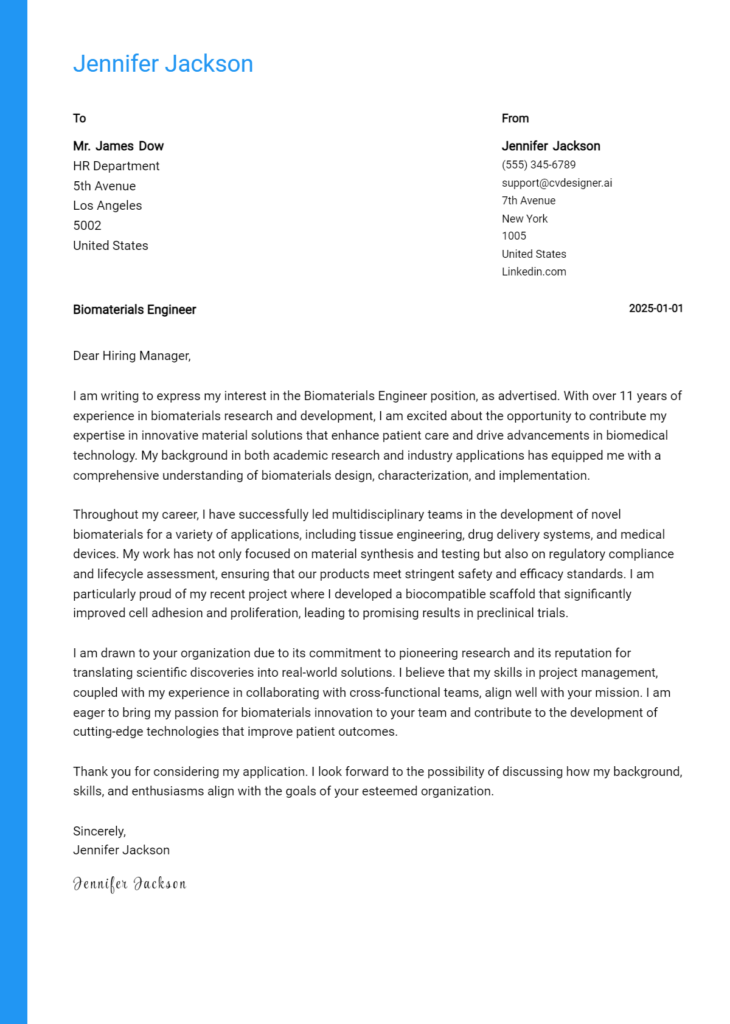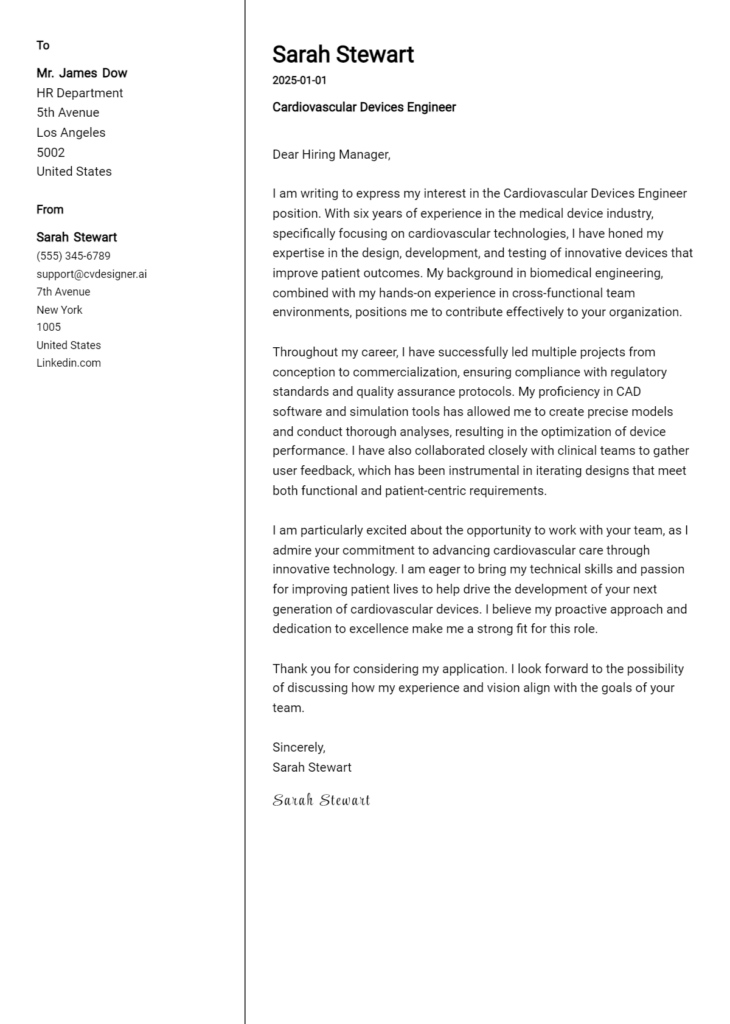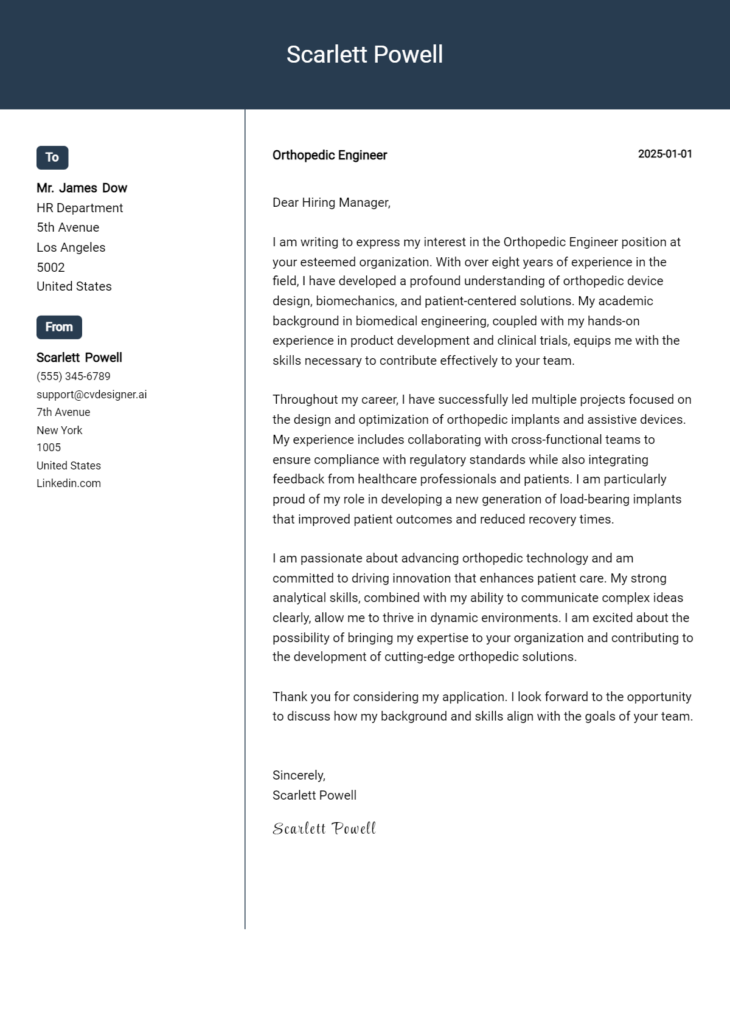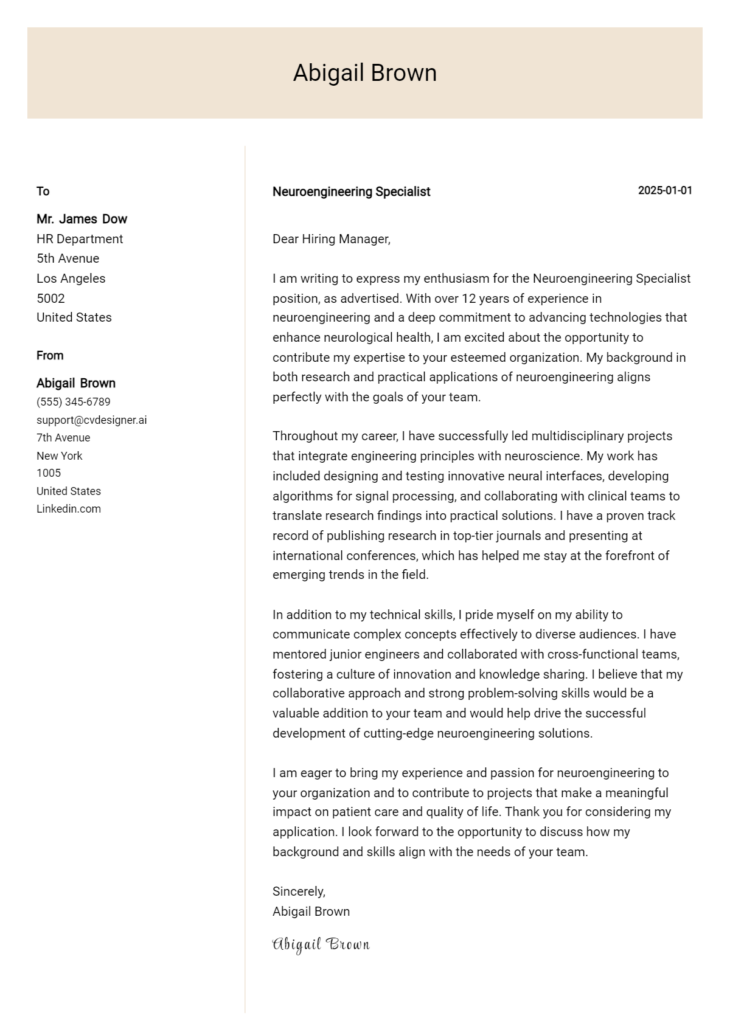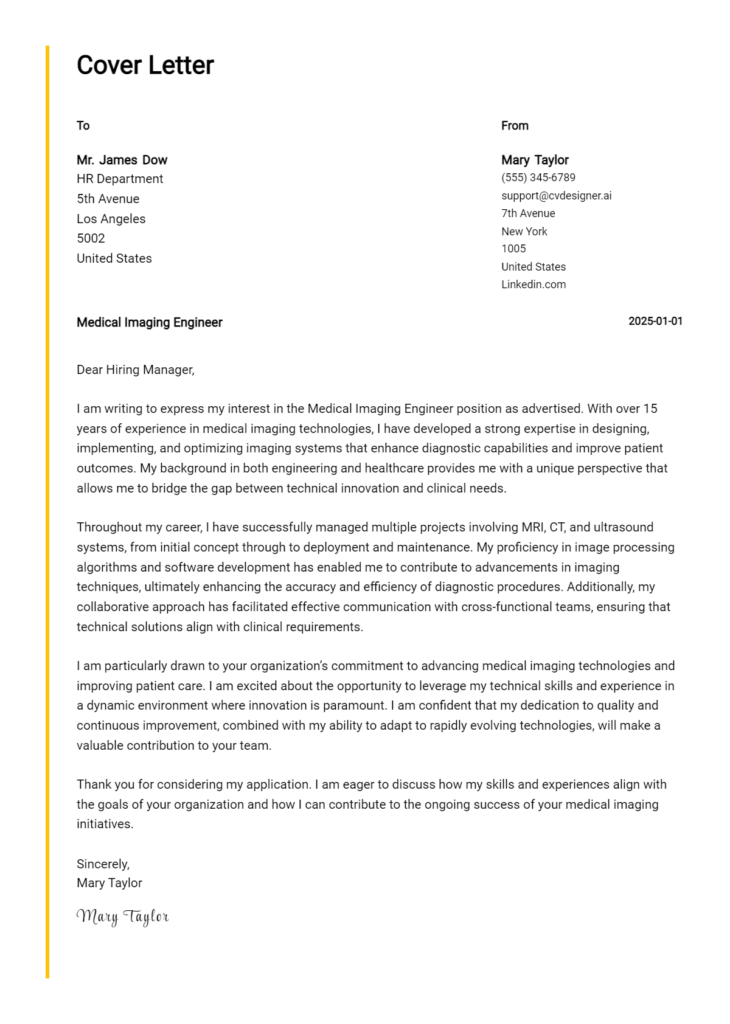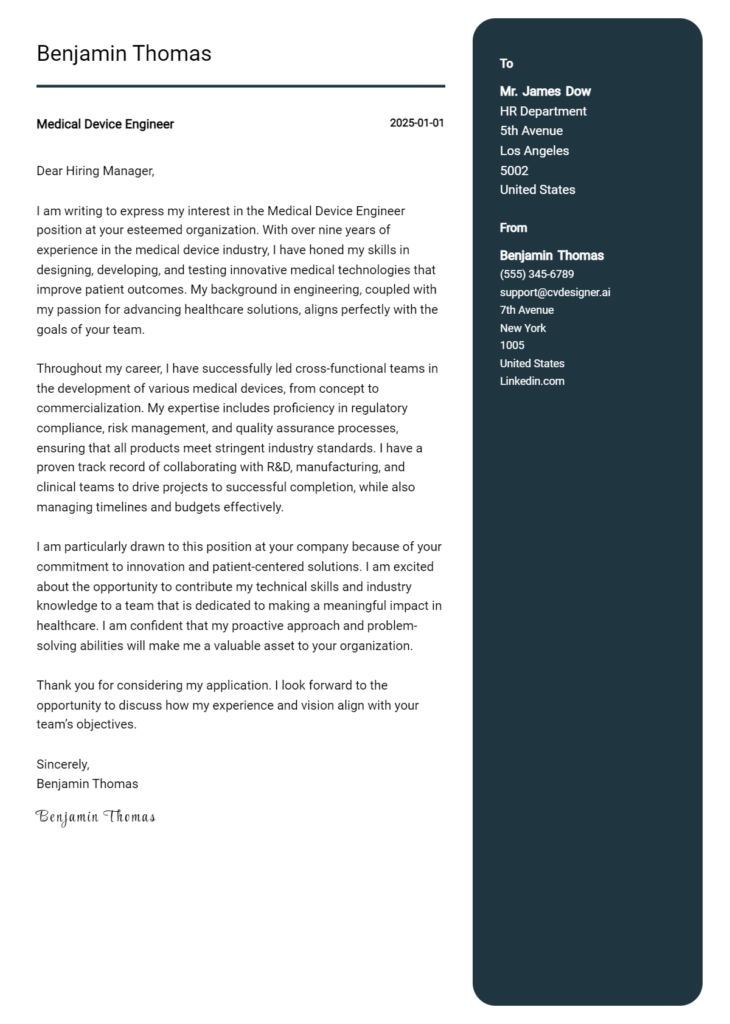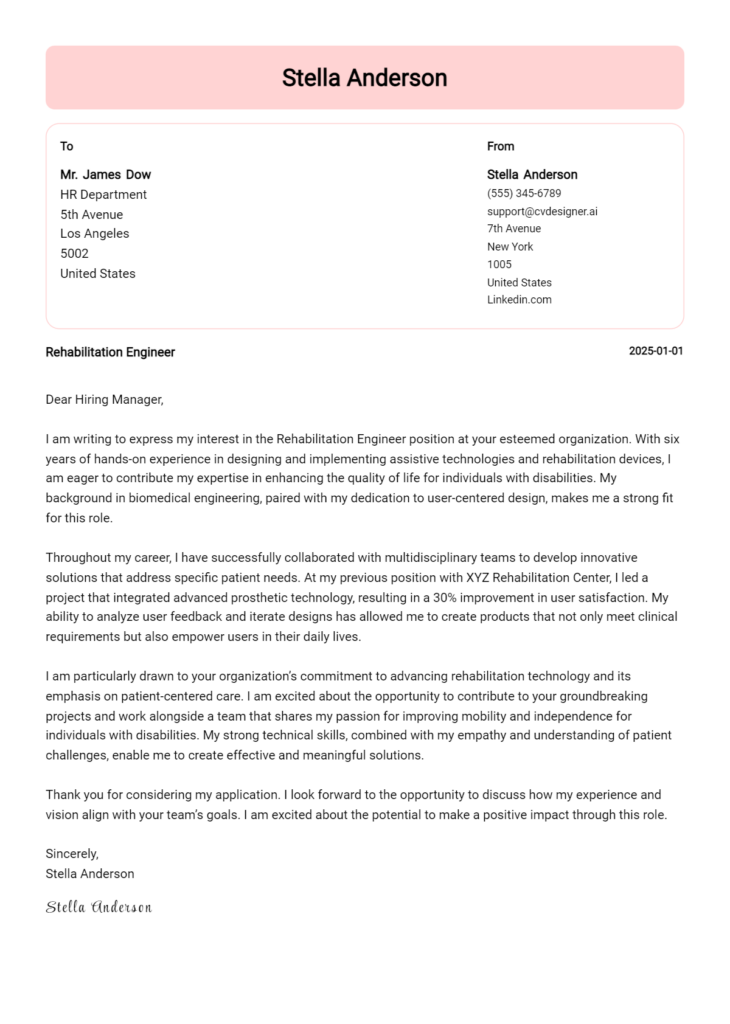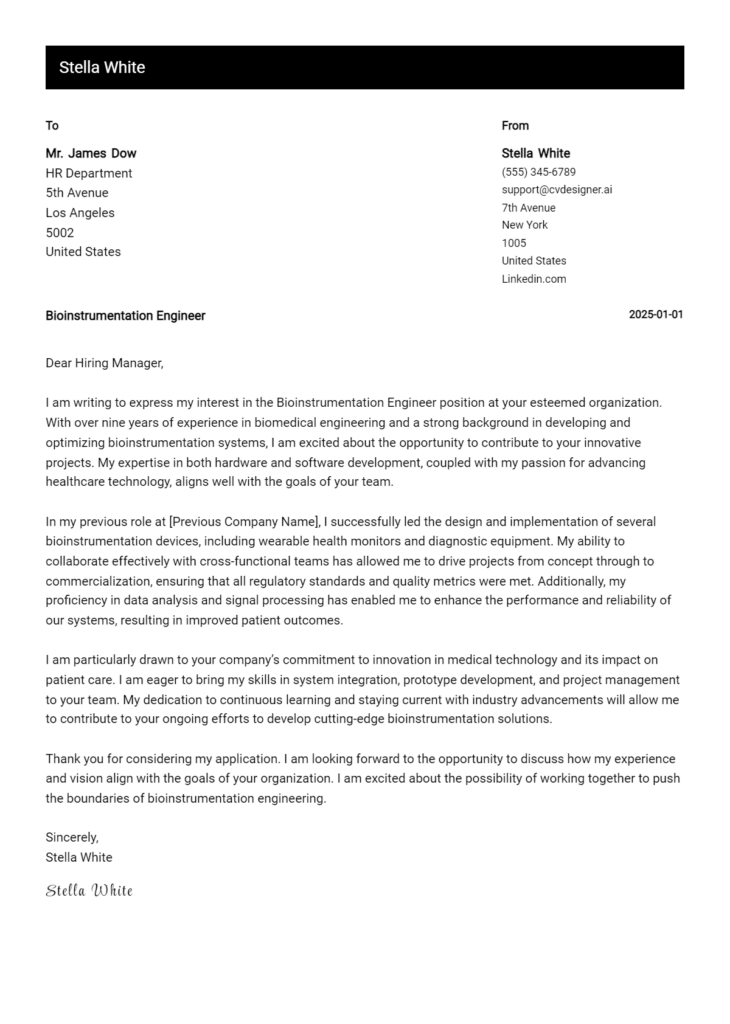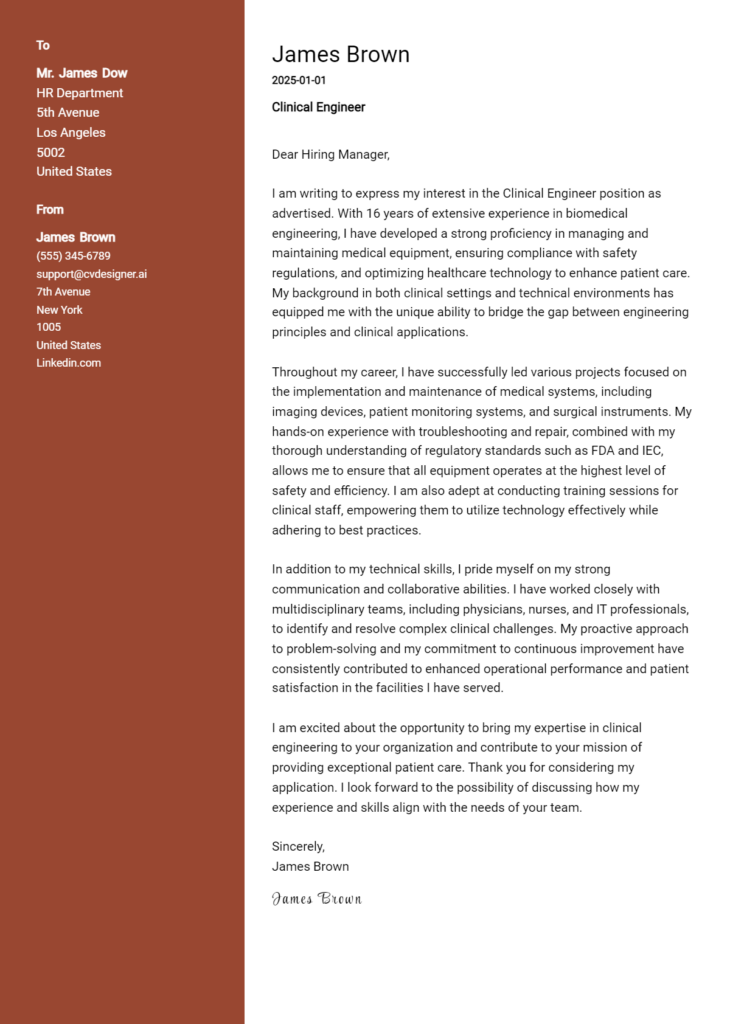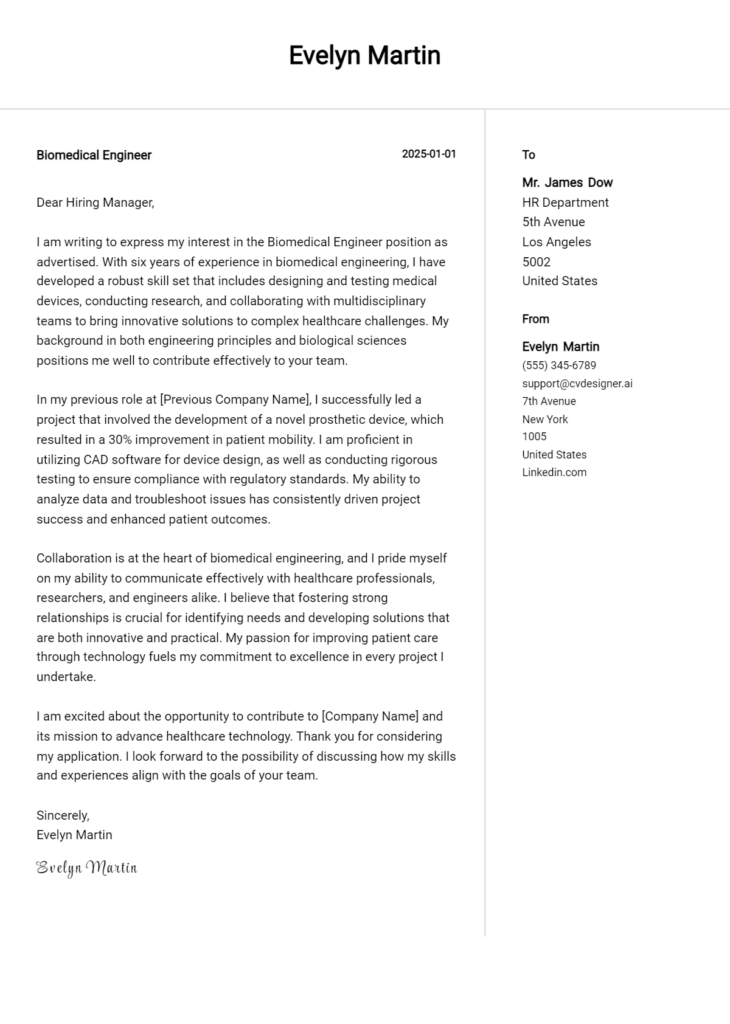Prosthetic Design Engineer 2 Cover Letter Examples
Explore additional Prosthetic Design Engineer 2 cover letter samples and guides and see what works for your level of experience or role.
How to Format a Prosthetic Design Engineer Cover Letter?
Crafting a compelling cover letter is essential for a Prosthetic Design Engineer, where the fusion of creativity and engineering precision plays a pivotal role in improving patients' lives. The way you present your skills and experience not only showcases your technical abilities but also reflects your empathetic understanding of patient needs and challenges. Proper formatting serves to capture the hiring manager's attention, emphasizing your attention to detail—an indispensable quality in the field of prosthetics.
In this guide, we'll outline how to structure your cover letter, providing insights and examples tailored to the prosthetic design engineering profession.
We'll focus on the essential components of a professional cover letter, including:
- Cover Letter Header
- Cover Letter Greeting
- Cover Letter Introduction
- Cover Letter Body
- Cover Letter Closing
Each section is crucial in illustrating your qualifications and professionalism. Let’s delve into each part and learn how to make your prosthetic design engineer cover letter stand out.
Importance of the Cover Letter Header for a Prosthetic Design Engineer
The cover letter header is a critical component of any job application, particularly for a Prosthetic Design Engineer. It serves as the first impression and sets the tone for the rest of the document. A well-structured header provides essential contact information, the date, and the recipient's details, ensuring clarity and professionalism. This not only helps the hiring manager identify the applicant quickly but also demonstrates the applicant's attention to detail and commitment to the application process. A clear and professional header reflects the candidate's organizational skills, which are vital in the engineering field.
Strong Example
John Doe 123 Engineering Lane City, State, ZIP johndoe@email.com (123) 456-7890 October 1, 2023 Hiring Manager ABC Prosthetics Company 456 Medical Way City, State, ZIP
Weak Example
johndoe@email.com 10/01/23 Dear Sir/Madam,
The Importance of a Cover Letter Greeting
The greeting of a cover letter plays a crucial role in setting the tone for the entire document. It serves as the first impression and reflects your professionalism and attention to detail. By addressing the hiring manager directly, you create a sense of personalization that can make your application stand out among others. Avoiding generic greetings like "To Whom It May Concern" is essential, as it can come across as lazy or impersonal. Instead, take the time to research the recipient's name, which not only shows initiative but also demonstrates your genuine interest in the position.
Here are some examples of strong and weak greetings for a Prosthetic Design Engineer cover letter:
Strong Greeting Example
Dear Dr. Smith,
Weak Greeting Example
To Whom It May Concern,
The Importance of a Captivating Cover Letter Introduction for a Prosthetic Design Engineer
A well-crafted cover letter introduction is crucial for a Prosthetic Design Engineer, as it serves as the first impression for the hiring manager. This opening paragraph should not only capture their attention but also express the candidate’s enthusiasm for the position while showcasing key skills and accomplishments relevant to the role. A strong introduction sets the tone for the rest of the letter and can significantly influence the hiring manager's decision to read further. Below are examples of both strong and weak introductions to illustrate the difference.
Strong Example
Dear [Hiring Manager’s Name], As a dedicated Prosthetic Design Engineer with over five years of experience in developing innovative prosthetic solutions, I was thrilled to discover the opening at [Company Name]. My passion for combining advanced engineering principles with cutting-edge materials has led to the successful design of adaptive prosthetics that have improved the quality of life for numerous patients. I am excited about the opportunity to bring my expertise in 3D modeling and user-centered design to your team and contribute to your mission of enhancing mobility for all.
Weak Example
To Whom It May Concern, I am writing to apply for the Prosthetic Design Engineer position. I have some experience in engineering and think this role might be interesting. I have worked on a few projects, but I am not sure how they relate to prosthetics.
Purpose of the Cover Letter Body for a Prosthetic Design Engineer
The body of a cover letter for a Prosthetic Design Engineer plays a crucial role in articulating the candidate's relevant skills, experiences, and the unique value they can bring to the company. It serves as a platform to highlight specific projects or accomplishments that demonstrate the engineer's technical expertise and innovative approaches. By detailing how their past work has contributed to improved patient outcomes or enhanced design efficiency, the candidate can effectively convey their commitment to advancing prosthetic technology and their fit within the company's vision.
Strong Example
Dear Hiring Manager, I am excited to apply for the Prosthetic Design Engineer position at XYZ Company. With over five years of experience in developing cutting-edge prosthetic devices, I have successfully led a project that resulted in a 30% reduction in manufacturing costs while improving the comfort and functionality of the prostheses. My collaborative work with biomedical engineers and therapists on a bionic limb prototype not only enhanced my technical skills but also deepened my understanding of user-centered design. I am eager to bring my innovative mindset and dedication to quality to XYZ Company, where I can contribute to creating life-changing solutions for patients in need.
Weak Example
Dear Hiring Manager, I am applying for the Prosthetic Design Engineer position. I have some experience in engineering and can work well with software. I think I would be a good fit for your company because I like helping people. I have worked on various projects, but I cannot provide specific details. Thank you for considering my application.
The Importance of the Cover Letter Closing for a Prosthetic Design Engineer
The closing paragraph of a cover letter is crucial for a Prosthetic Design Engineer as it serves to summarize your qualifications, reiterate your enthusiasm for the role, and encourage the employer to take the next steps, such as reviewing your resume or scheduling an interview. A strong closing leaves a lasting impression and reinforces your suitability for the position, while a weak closing may fail to convey your passion or urgency. Below are examples of both strong and weak closing paragraphs.
Strong Example
Thank you for considering my application for the Prosthetic Design Engineer position. With my extensive experience in biomechanical design and my passion for improving patient outcomes, I am excited about the opportunity to contribute to your team. I am eager to discuss how my skills and background align with the goals of your organization. I look forward to the possibility of an interview to further elaborate on my qualifications and ideas for innovative prosthetic solutions.
Weak Example
Thanks for reading my cover letter. I think I might be a good fit, but I’m not really sure. Please look at my resume if you want. I hope to hear from you soon.
Crafting an effective cover letter for a Prosthetic Design Engineer position is crucial for making a strong impression on potential employers. A well-structured cover letter not only highlights your technical skills but also demonstrates your problem-solving abilities, understanding of the software development life cycle (SDLC), capacity to work in teams, and a commitment to continuous learning. Below are some tips to help you create a compelling cover letter that showcases your qualifications and enthusiasm for the role.
Tips for Writing a Cover Letter for a Prosthetic Design Engineer
Showcase Technical Skills
Begin your cover letter by highlighting your specific technical skills relevant to prosthetic design. Mention any software tools you are proficient in, such as CAD software, simulation tools, or 3D modeling applications. Providing examples of projects where you utilized these skills can further demonstrate your capabilities. Consider using cover letter templates that help structure your technical expertise effectively.Emphasize Problem-Solving Abilities
In the field of prosthetic design, innovative problem-solving is key. Use your cover letter to describe a challenging project you worked on, detailing how you approached the problem and what solutions you implemented. This not only showcases your analytical skills but also your ability to think critically under pressure.Highlight Knowledge of SDLC
Understanding the software development life cycle is essential for a Prosthetic Design Engineer. Discuss your experience with SDLC phases such as requirements gathering, design, development, testing, and deployment. Provide examples of how you contributed to each phase in your previous roles, emphasizing your comprehensive grasp of the process.Demonstrate Teamwork and Collaboration
Prosthetic design often requires collaboration across various disciplines. Share experiences where you successfully worked as part of a team, whether on a project or within a research setting. Highlight your ability to communicate effectively and how you contributed to a positive team dynamic, which is essential in multidisciplinary environments.Express Passion for Continuous Learning
The field of prosthetics is ever-evolving, making a commitment to continuous learning essential. Mention any workshops, courses, or certifications you've pursued to stay updated with new technologies or methodologies in prosthetic design. This not only shows your dedication to personal growth but also your willingness to bring innovative ideas to potential employers.
By incorporating these tips into your cover letter, you can effectively communicate your qualifications and enthusiasm for the role of a Prosthetic Design Engineer. For additional support, consider using a cover letter builder to create a polished and professional document.
Common Mistakes to Avoid in a Prosthetic Design Engineer Cover Letter
Crafting a compelling cover letter is essential for standing out in the competitive field of prosthetic design engineering. Avoiding common mistakes can greatly enhance your chances of landing an interview. Here are some pitfalls to watch out for:
Generic Content: Using a one-size-fits-all approach can make your letter forgettable. Tailor your cover letter to the specific job and company by mentioning relevant projects or values.
Lack of Specificity: Failing to provide specific examples of your skills and achievements can weaken your application. Quantify your contributions, such as "improved design efficiency by 30% through innovative modeling techniques."
Ignoring Format Guidelines: A poorly formatted cover letter can distract from your qualifications. Follow established cover letter format guidelines to ensure clarity and professionalism.
Neglecting to Research: Not familiarizing yourself with the company’s mission or recent projects can show a lack of genuine interest. Take time to research and reference how your goals align with theirs.
Repetitive Information: Simply reiterating your resume can make your cover letter redundant. Instead, use it to highlight unique experiences that demonstrate your passion and problem-solving skills in prosthetic design.
Spelling and Grammar Errors: Typos can undermine your professionalism. Always proofread your cover letter multiple times and consider using tools or asking a friend for feedback.
Weak Opening and Closing: A bland introduction or conclusion can fail to engage the reader. Start with a strong statement about your enthusiasm for the role and conclude with a call to action, inviting them to discuss your application further.
For additional inspiration, explore our cover letter examples to see how successful candidates have effectively conveyed their messages.
Cover Letter FAQs for Prosthetic Design Engineer
What should I include in my cover letter for a Prosthetic Design Engineer position?
In your cover letter, emphasize your technical skills in design software, materials science, and biomechanics. Highlight specific projects where you successfully designed or improved prosthetic devices. Mention any certifications or degrees relevant to biomedical engineering. Additionally, showcase your understanding of user-centered design principles and how your work impacts patients. Don’t forget to express your passion for improving the quality of life for individuals with disabilities, as this aligns with the mission of many companies in the prosthetics field.
How can I demonstrate my passion for prosthetic design in my cover letter?
To convey your passion, share personal anecdotes or experiences that led you to pursue a career in prosthetic design. Discuss any volunteer work, internships, or projects that allowed you to work directly with patients or in clinical settings. You might also mention any organizations or communities you’re involved with that focus on rehabilitation or assistive technologies. By illustrating your commitment and connection to the field, you help potential employers see your enthusiasm beyond just technical expertise.
Should I tailor my cover letter for each job application?
Absolutely, tailoring your cover letter for each application is crucial. Research the specific company and position to understand their values, projects, and culture. Use this information to highlight relevant experiences and skills that align with their goals. For instance, if a company emphasizes innovation in prosthetic technologies, mention particular projects where you contributed to innovative solutions. A customized cover letter demonstrates your genuine interest in the position and shows that you’ve taken the time to understand the company’s unique needs.
How long should my cover letter be?
Aim for a concise cover letter that is no longer than one page. Typically, three to four paragraphs are sufficient to cover your introduction, relevant experiences, and a strong closing statement. Focus on quality over quantity; each sentence should add value and relevance to your application. Use clear language and avoid unnecessary jargon to ensure your message is easily understood. Keeping it brief and impactful will help maintain the reader’s attention and make a lasting impression.
Build your Cover Letter in minutes
Use an AI-powered cover letter builder and have your letter done in 5 minutes. Just select your template and our software will guide you through the process.



